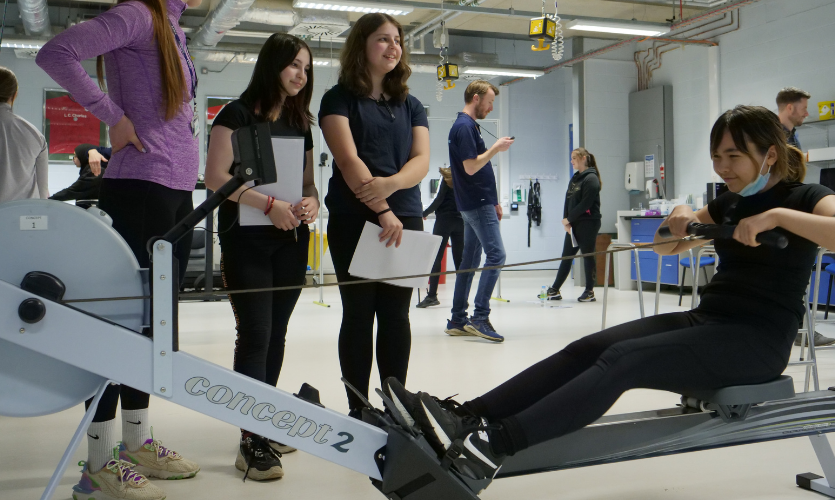Schoolgirl researchers visit world-class sport science labs
The pupils spent two days with LJMU experts gaining insight into sport science research methodology

Liverpool John Moores University, ahead of British Science Week (11-20 March), welcomed schoolgirls to its state-of-the-art sport and exercise science labs as part of a Royal Society partnership funded research project.
The year 9 pupils from Liverpool's Holly Lodge Girls’ College spent two days working alongside world-class scientists in physiology, biomechanics and sport and exercise psychology, as well as current LJMU students, to gain expert insight into sport science research methodology.
Utilising LJMU’s specialist research and teaching labs, the girls were trained in undertaking basic health assessments on each other including lung capacity, blood pressure, grip strength, heart rate and oxygen levels.
They then compared devices such as heart rate monitors and pedometers in how they capture physical activity data. These techniques will be applied to their very own project which aims to further understand the relationship between health, fitness and participation in physical activity in teenage girls.
“The project is trying to identify barriers as to why girls take part in less activity when they reach adolescence and the impact that has on their health”, explained Dr Tori Sprung, project team member and Strategic Lead for Equity, Diversity, and Inclusivity in LJMU’s School of Sport and Exercise Sciences.
Amazing array of role models
Dr Sprung hopes that through their findings the girls will not only become more aware of the benefits of taking part in physical activity, but that it will also encourage them to think about studying science at GCSE level and beyond, having worked alongside female scientists during their LJMU campus visit.
“We’ve exposed the girls to an amazing array of role models, many of whom are women and so in their own identity, they can really think ‘well if that person who looks like me can do that role, then so can I’ – those influences at a young age are just so important. I hope we have challenged assumptions they may have had regarding what a scientist looks like.”
During the visit the girls were also given a tour around the specialist sport science facilities from environmental chambers to VO2 max testing equipment, to aid their understanding of how sports science principles can be applied to professional athletes. They were also shown how to conduct focus groups and offered academic insight into the psychology behind participation in sport.
Holly Lodge science teacher, Miss Sarah Sung, was delighted for her pupils to put their previous experience in the classroom into practice while at the university facilities. “In the classroom we’re very prescriptive on the practical experiments that we require them to carry out and the skills that we need the girls to develop. By bringing the girls here we are providing them with a different context for that. So, the things that they learn in school, such as needing to repeat measurements to ensure they are valid, they can see that on a much bigger scale here at LJMU and it gives them more of a sense of how those skills [they learn in school] can then take them forward.”
Seeing beyond the white coats of science
Miss Sung also recognised that the time spent on campus was helping the girls to see beyond the ‘white coats’ of science and gender stereotypes.
“The stigmatism is that science is all white coats, so this is just trying to give them a flavour of what it’s like at university and the kind of things they could go into in the future. For some of our girls this is the first time that they’ve been to a university setting, so it’s really raising their aspirations. Plus, normally people talk about science being male dominated so this project is giving the girls the opportunity to speak with people like themselves, who have followed science through higher education, and the kind of roles that can lead them onto.”
The project, which will run for the rest of the academic year, will next see the pupils applying what they learnt at LJMU back in their school environment. The girls will continue to collect and analyse further data to identify ways to break down the barriers to teenage girls’ participation in sport.
Empowering the girls in their research
Experts from LJMU will visit the girls and their teachers at school in the coming weeks to assist with their data collection and analysis, and then support them as they draw conclusions from their research.
Dr Sprung added: “We aim to harness the ideas of the girls and empower them to lead on piecing together their findings, while also working closely with teachers and support staff at Holly Lodge. We hope to transfer these skills, and in doing so, embed this kind of activity in the school environment in a sustainable way.”
The project entitled How do we promote physical activity in girls? A research project with girls, for girls and by girls is funded by the Royal Society’s Partnership Grant Scheme, which aims to develop key skills for future careers while allowing pupils to see the range and reality of STEMM careers by working alongside scientists.
- The project is run in collaboration with the Physical Activity Exchange in the School of Sport & Exercise Science at LJMU - Dr Tori Sprung, Dr Cara Shearer, Dr Lee Graves, Milly Blundell, Dr Lawrence Foweather, Professor Lynne Boddy, Dr Fran Champ, Emma Cowley, Dr Gemma Miller, Dr Katie Hesketh and Professor Zoe Knowles.


